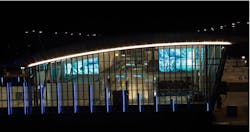A Crown Jewel for Queen City: Destination CLT Debuts Interconnected at Charlotte Douglas International
As the primary air travel hub for the Carolinas and gateway to much of the American Southeast, Charlotte Douglas International Airport services millions of travelers every year. Charlotte Chamber CEO Bob Morgan has touted the airport as “the No. 1 economic asset” in the region and reinforced the Queen City’s ardent desire to keep their airport’s facilities ahead of the curve. To that end, the city of Charlotte recently enacted a bold $2.5 billion renovation project entitled “Destination CLT,” which will renovate the concourses and expand the roadways, curb front, airfield and terminals by 2025. Charlotte is far from alone in this enterprising overhaul.
A secondary hub for American Airlines, Charlotte Douglas is just one of several high-profile airports to announce massive expansionary investments in the past year or two. Chicago’s O’Hare has a planned $8.7 billion renovation, New York’s JFK International announced an intended $10 billion project of their own, and Los Angeles’ LAX has a $14 billion improvement program underway. The case-by-case factors differ for each of these enormous undertakings, but the common thread governing all of them is clear: to maximize the unique positions they hold in their local economies and communities, modern airports must do more than simply move travelers from place to place. Today’s airports need to function as destinations in their own right. After all, any city worth going to ought to have an airport worth going through! Providing transit from Point A to Point B is presumably the raison d’etre of an airport, but airports themselves don’t actually do that — airlines do. Airports facilitate this transport, but they can –and should- aim higher. With Destination CLT, Charlotte Douglas finally is.
Reimagining the Passenger Experience
Travelers are spending less time at airports than they used to. Despite this, or maybe because of it, intrepid airports have at last reimagined the airport experience, this time from the perspective of the traveler. Think about how an airport is designed. It’s built so planes and cars can come and go efficiently. But what about people? Is their movement smooth? Decidedly not, most would agree. According to research from J.D. Power & Associates, the mood of a traveler in an airport has a high degree of correlation with how much money he or she spends while there, so by forcing travelers to endure the cramped terminals, bland decor, and obscured information of buildings designed for machines, an airport is harming itself, and crucially, its city, too.
Today’s airports have begun to address this dilemma by recognizing that travelers don’t just want to be somewhere, they want to feel somewhere. Often the first and last thing a traveler sees when they visit a new city, airports serve an important role in communicating and celebrating the region they service. In recent years, airport teams have recognized that digital display technology is precisely the kind of malleable solution with which they can cultivate an engaging and effervescent sense of place in their terminals. Taking the lead from other global airports with iconic digital art installations like Toronto Pearson Airport, Changi Airport, and the aforementioned JFK, Charlotte Douglas brought on a group of experts to create an experiential digital feature of their own. This feature would become the artistic centerpiece of the Destination CLT renovation and a defining emblem of the airport at large.
A Fusion of Technology, Art and Design
Giant municipally-funded projects of like Destination CLT typically include a set-aside portion of funds for artwork. Usually around 1-2 percent, this allotment can be used in whatever way the relevant actors deem appropriate. In this case, the Charlotte-Mecklenberg Arts and Science Council chose to commission for the airport a large digital visualization piece. Managed by the council from this point on, the project moved quickly.
Concluding that they sought the fusion of technology, art and design for the crown jewel of the Queen City airport, the team from Charlotte brought on an integration firm to help get the ball rolling. This firm helped refine the direction of the project, and from the start was able to communicate that, “[t]he goal here was to seamlessly integrate digital artwork that reflects…the airport’s data culture into the architecture of the new concourse.”
Frank Milesky, one of the integration partners heavily involved in the project, continued his summarization to say that, “[t]his install isn’t merely about displaying content, it’s about changing the entire passenger experience.”
With these ideals in mind, the next step was to find an artist who could bring this “data culture” to life. Enter Refik Anadol.
Anadol is a new kind of creative. A Turkish expat now living in Los Angeles, Anadol’s transformation of benign architectural facades into immersive digital canvases has won him regard in the display industry and far beyond. Regarding his mesmeric aesthetic, Anadol posits that his works, “explore the space among digital and physical entities by creating a hybrid relationship between architecture and media arts with machine intelligence.” Inspired, Charlotte’s Public Art Commission deemed Anadol the ideal craftsman to render visible the airport’s invisible patterns of information. Having found an artist, the logical next step was to provide him a canvas.
Finding the Right Tool for the Job
Thinking initially that projection technology might be the right way to showcase Anadol’s creation, this gambit was quickly ruled out by the physical and environmental demands of the space. The wall space in mind for the largest portion of the installation extended along a bland hallway in the expanded Concourse A, an area that was routinely flooded with ambient light streaming through the corridor’s many windows. The nearby locations for secondary elements of the artwork faced similar challenges. This light pollution rendered projection unworkable. The desire to fully immerse audiences with a seamless wall of content further nixed any thoughts of using LCD technology, which would have required unsightly “bezels,” or black crosshatch lines, between monitors. Recalling previous experience working with large-format LED solutions, Anadol quickly pounced on that form of technology once it was brought forth as an option. “The main display is huge,” remarked Melinsky, “and because it is visible both inside and outside the airport the high brightness quality of the [LED] displays was essential here.”
Today, Concourse A of Charlotte Douglas International is adorned with three enormous LED displays that cover over 2,000 square feet combined. Two displays fit snugly into corner areas that were once relegated to ignominy as wasted dead space in the Concourse A atrium. Of these displays, one measures roughly 36 feet wide by 18.5 feet tall while the other checks in at around 28 feet wide by 14 feet tall. The third and easily most striking display lives along the wall in the once-bland hallway detailed above. Bordered on one side by near floor-to-ceiling windows, the hallway’s inside wall now beams with a 140-foot-by-10-foot behemoth of a display. This giant features a 2.5 millimeter “pixel-pitch,” the measurement of how close together adjacent pixels are, while the two others both use a 4.7 millimeter pixel-pitch. The displays are mounted flat on their respective wall surfaces and due to their slim 3-inch depth and lightweight nature, they embed seamlessly without any bulky framework jutting out. The three displays are synchronized together to stream distinct visual chapters of Anadol’s making. They are entitled “Fluid Structures,” Impossible Materials,” and “Data Poems.”
Interconnected Holds You, Even When You Leave
Dubbed Interconnected by its creator, the artwork on the displays is at once magnificent and perplexing. Anadol says that the piece, “is constantly changing and evolving as it responds to the ever-changing flow of data, creating a living snapshot of the invisible patterns that surround us as we travel.” He created the piece around the idea that data is a substance. Unless you’re Anadol, it’s hard to understand the machinations governing the visuals, but that’s hardly where the mind goes when looking at these displays. Comprehension isn’t really the point — immersion is.
True to this end, the essential quality of Interconnected is its fluidity. From each angle and distance it pulses differently. Staring at the hallway length display as you glide along the adjacent moving walkway, curling visuals can churn your focus like a river hydraulic. Repeat that glide an hour later and the same screen may take your imagination to the surface of Mars. The imagery is so richly textured that audiences can’t help but reach out to it, an act that leaves you consumed in a pool of data in which you are both solvent and solute. As for the smaller displays high above the ground, they sometimes seem like the belly of a water tower, holding in millions of gallons of arrivals, departures, checked bags and parking availability. Other times, they conjure mental images of a space station, lasers of passenger data shooting out from some twisting central core. That Interconnected is visible from the street for motorists and pedestrians allows this art to cast outward beyond the walls of Charlotte Douglas, rising the interest of even those just passing by. To those around, it’s unavoidable.
Much of the imagery would seem right at place in the title sequence of a James Bond film. Or in the deepest sci-fi depths of a CGI-centric Marvel movie. Or perhaps even on the jumbotron anytime Phish plays at Madison Square Garden. The visuals linger with you though they themselves disappear quickly. By design, audiences will never see the same content twice. It’s almost overwhelming, but it is exactly the experience Charlotte Douglas hoped to encourage when they began Destination CLT.
The Lesson: Don’t Just Rebuild, Rethink
Throughout its still-ongoing progress, Destination CLT has been driven by a total commitment to the reimagination of the modern air travel experience. The physical renovations both indoor and out are meant to offer travelers a heightened airport experience that finally considers their needs alongside those of the airlines. Granted, Destination CLT includes construction of a new runway, the addition of nine new gates, an expanded terminal curbfront, and a new air traffic control tower, but for the 45 million everyday travelers that move through Charlotte Douglas each year, the more meaningful changes involve the installation of electrochromic windows, the hundreds of new charging ports, and of course, Interconnected. After all, these are the things they will interact with during every visit.
Passengers are not going to hang out at airports all day anymore, so airports need to make an enduring impression in the short time they have. That an airport could be more than just a glorified transfer station is still possible, but it takes a practical and artistic overhaul on the scale of Destination CLT to achieve. Charlotte Douglas wanted to connect with their travelers to communicate the value, and values, of the greater Queen City community. They also wanted to loudly establish that CLT is an airport destination of the future. By introducing an unforgettable artistic triumph in the form of Interconnected, it sure seems like they succeeded on both counts. Data culture, indeed.
With more than 20 years of business and market development and analysis in a variety of industries, Brett Farley manages strategic market and key account development at NanoLumens, focusing heavily on the aviation-transportation, P3 and CRE sectors and associated ecosystems. Prior to joining NanoLumens, Farley held similar positions at Liaison Technologies, nuBridges, PointClear, SIMCOM International, NAVEX Global, and Dun & Bradstreet. Farley is a graduate of the University of Arizona with joint B.A. Degrees in Journalism/Marketing and holds an MBA in Decision Sciences and Business Analysis from Georgia State University.
About the Author

